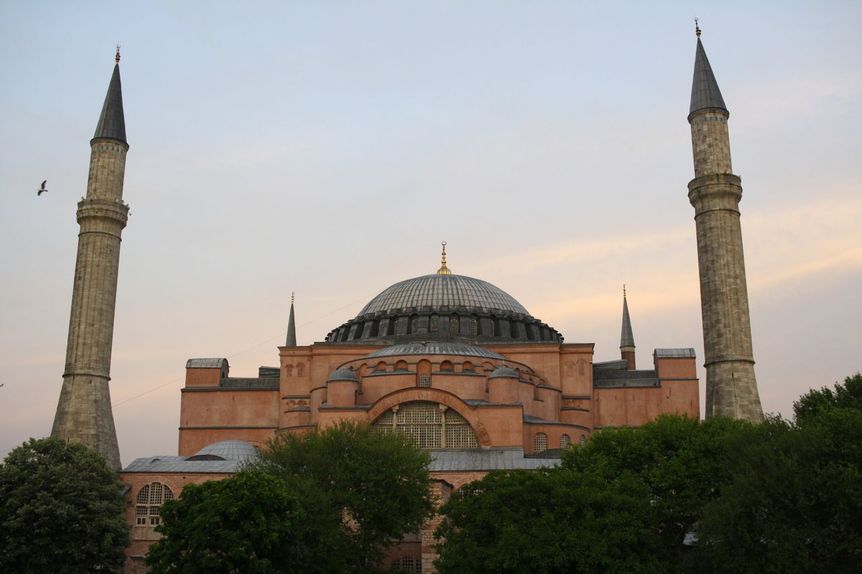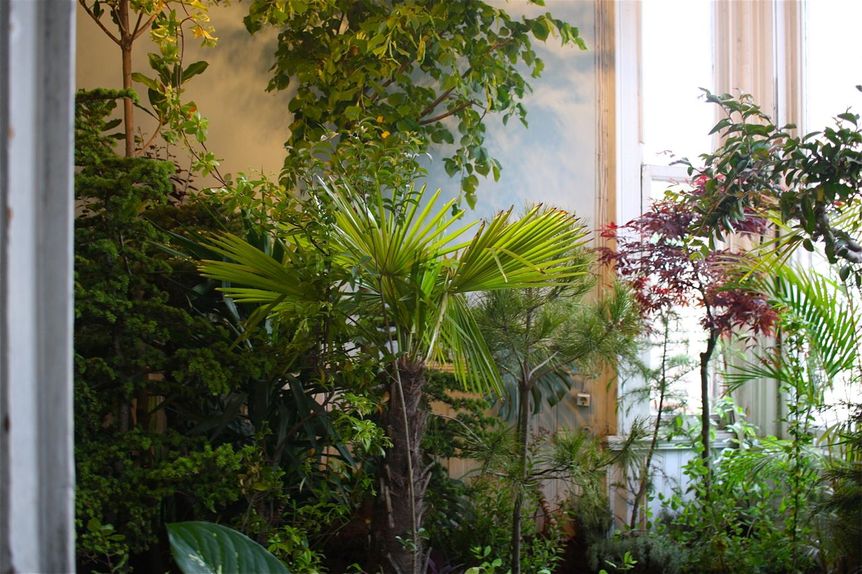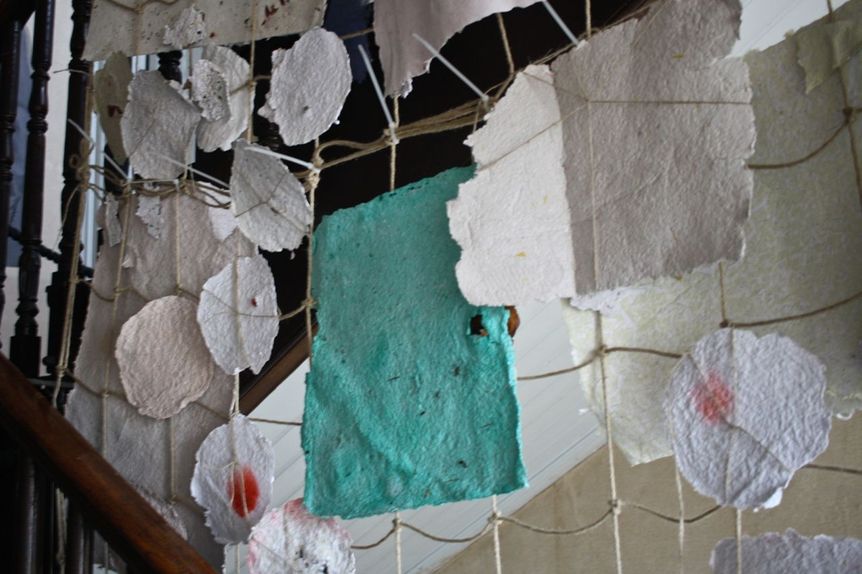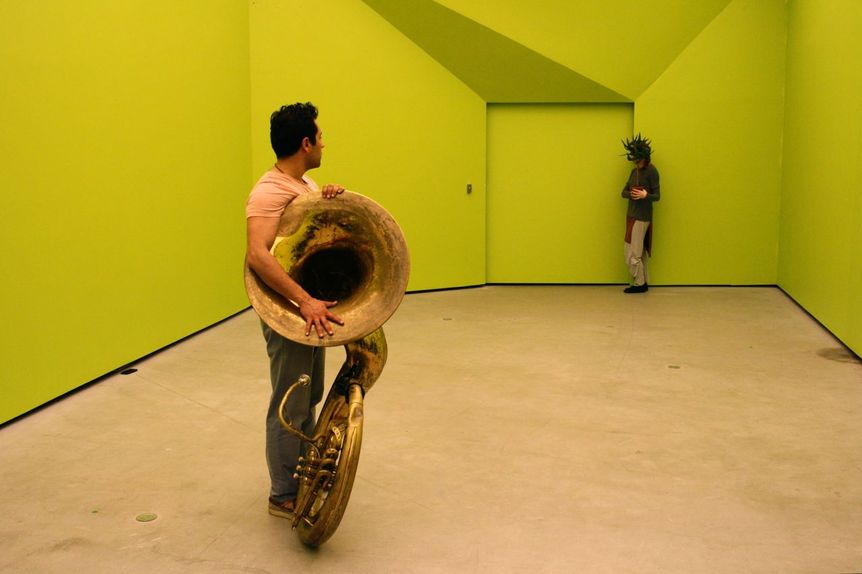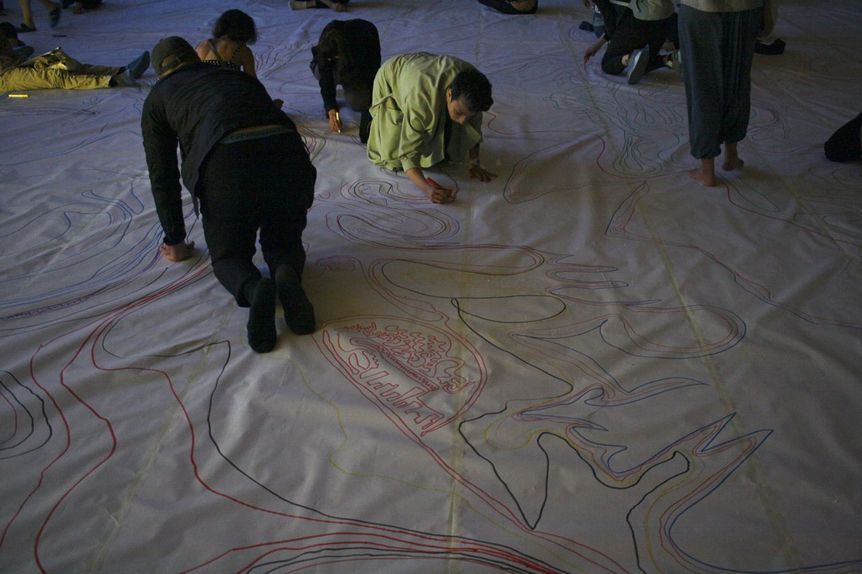
R
E
V N
E
X
T
It was an unusually humid spring weekend in Istanbul—earthquake weather—with hazy sunshine and the pollen of flowering trees mixing with the city’s persistent smells of exhaust and cigarettes. The giant metropolis was reawakening from a dark winter, capped by a divisive, fraud-tarnished referendum in mid-April, held under the state of emergency implemented after last July’s attempted military coup.
The mood among those who gathered that evening at the Abud Efendi Mansion, a decaying late-Ottoman residence near Aya Sofya (Hagia Sophia) for Sharjah Biennial 13’s (SB13) off-site project, “Bahar” (“Spring”), was subdued but willful. No one seemed happy but no one wanted to talk about it either. The environs, at least, were different—an unfamiliar combination of the familiar. A street vendor was serving pilaf while a band played traditional folk songs inside a rundown basketball gym, which, in the 1930s, had been attached to the stately house located in the tourist-starved historical peninsula, a part of the city rarely used for contemporary cultural events.
Blooming white flowers on an overgrown myrtle tree in the front courtyard signaled an atmosphere of regrowth. In the house, just off the entrance foyer, two artworks immediately evoked the spring theme: a turgid, potato-like sculpture bulging from the balcony, by Ülgen Semerci and Burcu Yağcıoğlu, and a room-filling micro forest of soil and plants by João Modé, titled Essence / Seeds from Brazil, Land (2014/17). In the back room—on the way to the basketball court—was a two-channel video about fish swimming upstream, projected onto an arrangement of domestic furniture and fabrics, by Pinar Öğrenci, Only Dead Fish Go With the Flow (2017), as the migration of the silver mullet in an eastern region of Turkey takes on political overtones.
The exhibition and performances of “Bahar” formed the second off-site chapter of SB13, following Kader Attia’s two-day symposium in Dakar, Senegal, in January, on the theme of water; and SB13’s mid-March Act I in Sharjah, which SB13 curator Christine Tohmé had presented. In dialogue with Tohmé and the other interlocutors, Öz’s “Bahar” comprised newly commissioned artworks and performances, around the motif of the crop and its metaphorical potential for storing energy, surviving underground, and waiting for the right time to grow. In format, “Bahar” follows Öz’s own curatorial series of commissions and exhibitions, called “Produce” (double entendre intended), supported by the nonprofit education group Spot, and extends Tohmé’s larger ambition to utilize the platform of SB13 to support local and regional cultural networks currently being squeezed by a variety of political and cultural pressures.
The artworks of “Bahar” were primarily displayed in the rooms of the four-storey mansion, while a program of performances took place on the following evenings (a series of related talks and films had been held at Salt Galata in late March and early April). Of the existing works, Joana Hadjithomas and Khalil Joreige’s Latent Images project (1997–2006)—which features descriptions of the photographs on 38 rolls of film taken, but not developed, by the fictive persona Abdallah Farah during years of conflict in Lebanon—best exemplified the idea of artistic works lying in dormancy during troubled times. Onur Gökmen’s video All the Rivers Run Into the Sea, Yet the Sea is Never Full (2017), with a title from Ecclesiastes 1:7, shows three men transferring a cement-like slurry from one metal jug or silo to another, in a metaphorical-seeming action about the continual transference of a material, which is in a transitional state between liquid and solid. Coming into being again, re-learning, and recovery, were themes suggested by Olivia Plender’s audio installation Learning to Speak Sense (2016), which features a person practicing syllables with a speech therapist, using lines taken from an essay by suffragette Sylvia Pankhurst about being on a hunger strike: “one’s mouth and throat are terribly parched, one’s tongue is dry, hot and rough and thickly coated.” The rejuvenation is a chance to rethink the political terms of engagement as well, Plender’s work suggested.
While I appreciate the importance of commissioning new works, especially in Istanbul, where arts institutions have atrophied, many of those in “Bahar” appeared unresolved and more like first drafts. There was potential in them, though it often didn’t feel realized. Deniz Tortum’s video Computer at Night (2017), for instance, featured a cryptic monolog about ascension to heaven and the functioning of autonomous computer networks, paired with visuals made from point-cloud data scans of the Aya Sofya’s interior and 3D renderings of buildings on the historical peninsula. In the same speculative-futuristic bent was Ali Taptık’s ArchieveSET 14.0, an animated video imagining the direction of data storage and personal information, paired with an monitor that, via a QR code, gave viewers access to PDFs of three related short stories Taptık has written and set in a post-World War III era with extreme climate change and the rise of city-states. (I read these later, not while standing in the exhibition.) In Merve Ertufan’s installation Can An Answer Be Surprising? (2017), she projected lines of text from an imagined dialogue (with one’s self, or someone else) onto two halves of a curving surface—a work that had moments of humor and intrigue but didn’t feel fully realized yet. I was clueless about Sena Başöz’s room installation of stacked cardboard boxes, and pink plastic balls, In the Uncertain Light of Single Certain Truth (2017), which was supposedly about “the prospects of liberated desire in the current state of the world,” while Bengi Güldoğan’s Kalhana was at least quite literal: a tabletop installation of seeds, a model of a ruined settlement and a bio-mechanical form resembling a locust and agricultural machine. The only artwork that captured the exhibition’s themes and seemed ready to stand on its own in another context was Aslıhan Demirtaş’s It Is Always Spring (2017), a Dan Flavin-esque wall of pink-hued “grown-lights” (grolux fluorescent light tubes that simulate the sun’s wavelength), accompanied by a melodious pop tune called Agrosomnic Dreams composed by Tolga Tüzün, which is meant to serve as the imagined soundtrack for a farmer of the future tending crops in an “ultra-tech” greenhouse.
Several parts of the programming for “Bahar” incorporated the activities of existing collectives and small-scale initiatives, much to their detriment. In the hamam of the old mansion, the Istanbul collective DAS Art Project organized a display of seven member-artist’s works called “Genetically Modified,” into which had invested more energy in the packaging than the content—exemplified by the collective’s sculpture Generic (2017), an empty plastic water bottle printed with a transparent label listing ingredients it did not contain (“Ethinyl Estrdiol Free,” “High Fructose Corn Syrup Free,” and so on). “Can you create feeling in a laboratory?” “Are transformations organic or just changes with predetermined rules?” “Would Hilter be against GMO?” These were some of the ironic-pretentious questions listed on DAS’s exhibition brochure, but I’m not sure artworks like Beril Ece Güler’s video Home-grown (2017), showing old family photographs projected onto the side of a building at night, or Tarık Törek’s painting of an electric-pink skeleton on horseback, Death IV (2015), are capable of addressing much beyond a fascination with their own youthful solipsism.
This tendency of newer artist collectives to want credit for meager artistic output was also evident in the project K’aad, Kaat, Kayıt, Kağıt (2017), a rope web adorned by pieces of homemade paper that was produced by the five-artist collective Signs of Time, hanging down the mansion’s stairwell. “The conversations of the group of artists who got together regularly for two months turns into a surface,” we read about the work. It’s hard to understand how much more meaningful these unremarkable little pieces of paper—yes, some are embedded with seeds or dried leaves, but so what?—can be than any other craft project. Except, in this context, perhaps the underlying assumption is that five young people getting together and talking (about what, we have no idea) is itself an act of interest. It is not. Can’t we expect something more ambitious and imaginative from five young artists instead of these scraps? I understand that Signs of Time could be seen as metaphorically “hibernating,” producing this paper in lieu of something more directly about recent life in Turkey, but even this attitude reveals a very limited understanding of art’s potential to communicate in interesting and meaningful ways with people beyond ourselves.
Similarly humdrum was Ayça İnce and Begüm Atakan’s pickling workshops for their project Pickled It! (2017), which is an outgrowth of the urban farming and healthy-food initiative Ek Biç Ye İç (meaning “Plant, Harvest, Eat, Drink”), an organization whose aims I find entirely sympathetic. The project’s metaphor, as explained in the brochure—“Pickling and fermentation are ancient techniques of preservation and intensification of the nutritional value of vegetables. Seemingly dormant produce is transformed by teeming microscopic life in the pickling jar”—was perfectly obvious, but it does a disservice to force a micro-initiative like Ek Biç Ye İç into an exhibition context, where jars of simple home pickles and little cutting boards of vegetables look so mundane as to be uninspiring. An actual artwork, something of interest, would incorporate pickles as a material, not merely as an end in itself.
Collective projects don’t need to be synonymous with insularity. On the afternoon of Sunday, May 14, the dance collective called A Corner of the World organized a series of nine short performances called “Walk Around the Corner Bomonti” in a renovated brewery-turned-leisure complex called Bomontiada. The group had previously held a similar project utilizing nearby independent spaces in a neighborhood of Kadıköy, the district on Istanbul’s Asian side where much of the city’s creative energy has relocated in recent years. The program kicked off outdoors with a Bollywood-goes-to-the-beach dance, Hippies for Sale, by Gizem Aksu, and was highlighted by Seçil Demircan’s Dis/connection, a humorous duet in a green-painted room within the art space Alt, involving a guy playing a tuba, and the artist herself with a smartphone and a potted plant.
The real highlight of “Bahar”—Onur Karaoğlu’s ambitious and experimental performance Minority Stress – Things I Think But Cannot Say—was back at Abud Efendi Mansion later that evening. At the door, we were each given a colored marker and sheet labeled “Space Protocol” that outlined the rules for the performance. We entered the gymnasium where the floor was completely covered in white paper, and illuminated by a single source of light and ambient music. The instructions told us to put the marker to the paper and not let up for 25 minutes, with the caveat that we were not allowed to draw across other people’s lines. There were several dozens of people doing this at once, interweaving their paths on the floor around the room and creating rainbow-colored shapes in the process. Eventually you found yourself stuck, with no direction to go that didn’t mean crossing another line, and you ended up sitting on the floor, watching others still on their adventures. Once we had created the “labyrinth,” the director, Karaoğlu, introduced his three friends, Aren, Berk and Can, who each recited what we were told were “things they think but cannot say”—monologues that were perhaps developed in collaboration with the actors themselves—which were crude, somewhat harsh thoughts about people whom they seemed to know (a guy who farts in public, one who is groped by a burqa-wearing woman on a bus, another who adopts a stray dog). In between, the actors would run, stomp, somersault, writhe or leap around—like they were letting out primal emotions—until Onur would call out “Question!”, at which point they would stare at a person closeby to see if they wanted to ask a question, to which they would respond with a hysterical laugh or outsized gesture before continuing their spastic roaming on the labyrinth. In the third act, after 42 rounds of questions, the three performers entered into a dance of synchronous motions that followed Karaoğlu reading words or short phrases (“Don’t Hold Your Breath,” “Waves,” “Struggle,” “Power”). Somehow, from our individual journeys around a room with a colored marker to its incantatory climax, Karaoğlu created the sensation of having undertaken a collective psychic journey. Alternately engaging, strange and poignant, and, in its format, unlike anything else I’d ever experienced before, Minority Stress was the ambitious accomplishment in “Bahar,” one that signaled the potential that lies in generous, participatory experiences—especially after another long winter, and with the prospect of many more to come, here in Turkey as elsewhere.
HG Masters is editor at large of ArtAsiaPacific.
To read more of ArtAsiaPacific’s articles, visit our Digital Library.
